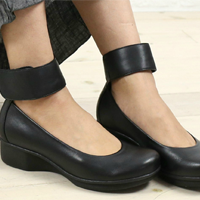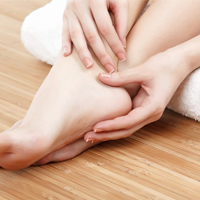The Facts About Caring for the Fabulous Foot

If several hundred tons of pressure seems like a lot to bear, that sum may help you appreciate how hard your feet work.
An average day of walking brings a force equal to several tons of pressure to bear on your hardworking feet. That may explain why your feet are more subject to injury than other parts of the body.
The human foot is a biological masterpiece. It’s strong, flexible and functional design enables it to do its job well and without complaint-if you take care of it-yet foot ailments are among the most common health problems.
Although some can be traced to heredity, many stem from the cumulative impact of a lifetime of abuse and neglect.
Studies show that 75 percent of Americans experience foot problems at some time in their lives, but few seek medical treatment because they mistakenly believe that discomfort and pain are normal and expectable.
A number of systemic diseases are sometimes first detected in the feet, such as diabetes, circulatory disorders, anemia and kidney problems. Arthritis, including gout, often attacks foot joints first.
Specialized Care
Your feet require specialized care and Doctors of Podiatric Medicine (DPMs) are the physicians and surgeons who practice on lower extremities, primarily on feet and ankles.
Most DPMs undergo four years of undergraduate work, followed by four years in an accredited podiatric medical school, followed by a hospital-based residency.
A doctor of podiatric medicine can make an important contribution to your total health, whether it is regular preventive care or surgery to correct a deformity.
Since self-treatment can turn a minor problem into a major one, you may want to learn about common ills that affect the feet and promptly see a podiatrist if these conditions occur or persist:
Athlete’s foot is a skin disease, caused by a fungus, that commonly attacks the feet. Signs are dry scaly skin, itching, inflammation and blisters. Blisters are caused by skin friction. They should not be broken but bandaged.
Bunions are misaligned toe joints that can become swollen and tender. Corns and calluses are protective layers of compacted dead skin cells caused by repeated frictions. Do not cut them off.
Foot odor results from excessive perspiration.
Hammertoe is a condition in which any of the toes are bent in a clawlike position. Surgery may be necessary to realign the toes.
Heel pain is generally traced to faulty biomechanics that place too much stress on the heel bone, ligaments or nerves in the foot.
Heel spurs are growths of bone on the underside of the heel bone. Both heel pain and spurs are often associated with plantar fasciitis, an inflammation of connective tissue. Ingrown nails are nails whose corners or sides dig painfully into the skin.
Neuromas are enlarged, benign growths of nerves, most commonly between the third and fourth toes, but removal is sometimes necessary. Warts are caused by a virus and can easily be removed.
The American Podiatric Medical Association recommends these tips to keep feet healthy:
1. Don’t ignore foot pain; it’s not normal.
2. Inspect your feet regularly for thick, discolored nails, cracks or cuts, peeling or scaling.
3. Wash feet regularly and dry completely.
4. Trim toenails straight across but not too short. Don’t cut nails in corners or on the side since this can lead to ingrown toenails.
5. Make sure shoes fit properly.
6. Select the right shoe for the activity you are engaged in.
7. Alternate shoes.
8. Avoid walking barefooted.
9. Be cautious about using home remedies.
10. If you are a person with diabetes, see a podiatric physician at least once a year for a checkup.
To learn more about treating foot problems, see the podiatrist.
The human foot is designed to do well if you take care of it and see a podiatrist when you experience pain or discomfort.


